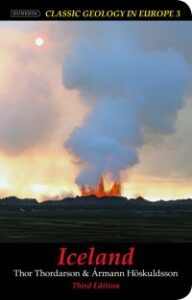by Thor Thordarson and Ármann Höskuldsson

I reviewed the 2nd edition of this guide a while ago (see Iceland: Classic Geology in Europe 3), and, as I said then, Iceland seems to set the hearts of certain geologists racing and, reading this field guide and that previous incarnation, it is abundantly clear why.
Iceland’s fascinating geology is clearly set out in this concise and authoritative book. The island, astride the Mid-Atlantic Ridge, is a ‘natural laboratory’ where the earth sciences can be watched in real-time. Rifting of the crust, volcanic eruptions and glacial activity are among a host of processes and features that can be observed in this fascinating land.
In fact, the volcanic and tectonic processes active in Iceland have given rise to the best exposed examples of seafloor rifts anywhere in the world. In fact, nowhere else on Earth is the volcanic and tectonic architecture of seafloor rifts better exposed. And, together with the erosive power of icecaps, extensive river systems, thunderous Atlantic waves and climate change, the geology of this island displays, in the most dramatic way, the balance between constructive and destructive geological processes.
It is also clear that large icecaps and extensive river systems grind down the volcanic rocks at rapid rates, dispersing and forming thick sequences of sediments, which are further modified by huge North Atlantic storms, giving rise to extraordinary landforms. For the last seven million years, Iceland has also been located at the boundary of major air and ocean masses, and has therefore been exposed to extreme climate changes. In fact, the effects of the climate on the rock-forming processes are clearly illustrated by diverse sedimentary and volcanic successions, and by the wide range of volcanic landforms formed in sub-aqueous to sub-aerial environments.
In addition, Iceland is the only part of the North Atlantic Large Igneous Province that is still active and the only place on Earth where the construction of such provinces can be observed directly. For this reason, it is a window into the formation of proto-continents early in Earth history.
The guide is full of colour photographs and diagrams. It starts by setting out an overview of the geology of Iceland and then puts it in its geological and global setting. Only then does it introduce the science of plate tectonics and volcanism, and its difficult terminology (fortunately, covered by an extensive glossary). It then discusses, in detail, location profiles throughout the island, which a visitor can visit to understand Iceland’s geology and the geological processes that gave rise to the extraordinary geomorphology that is visible there.
Finally, it is worth noting that Icelandic culture cannot be fully understood without understanding its geology. Therefore, the book will interest not only students and amateur and professional geologists, but also those attracted by the natural environment, who seek a deeper understanding of what makes Iceland unique. If you are thinking of going there (as I am later this year), you really should think about buying this excellent guide.
Thor Thordarson received his PhD from the University of Hawaii at Manoa. He is now at the Faculty of Earth Sciences, University of Iceland, having worked previously at the University of Edinburgh, the University of Hawaii at Manoa, CSIRO in Western Australia, the IGNS Volcanology Group in New Zealand, and the Nordic Volcanological Institute, Reykjavík. Ármann Höskuldsson gained his PhD at l’Université Blaise Pascal, Clermont-Ferrand. He is now with the Institute of Earth Sciences, University of Iceland and was previously the Director of the South Iceland Institute of Natural History in Vestmannaeyjar.
Iceland: Classic Geology in Europe (3rd edition), by Thor Thordarson and Ármann Höskuldsson, Dunedin Academic Press (2022), 280 pages (paperback), ISBN: 9781780460925.


